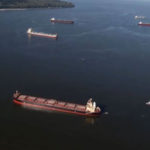Evolution of shipping’s commercial models
 As the shipping industry confronts the climate challenge, the evolution of business models becomes imperative, according to Danish Ship Finance.
As the shipping industry confronts the climate challenge, the evolution of business models becomes imperative, according to Danish Ship Finance.
In its latest Shipping Market Review, the shipping loan provider warned that traditional tonnage providers face disruption, calling for a shift towards long-term contracts and increased collaboration to reduce emissions.
This shift is not merely a response to regulatory pressures but a recognition that business model innovation holds the key to unlocking untapped potential and driving a consolidation wave among smaller players.
The International Maritime Organisation regulations have set the course for reducing greenhouse gas emissions, with operational measures expected to deliver short-term reductions by 2030 and new fuels driving the industry towards net-zero emissions by 2050. The global regulatory framework, combined with the European Union’s introduction of a regional carbon price from 2024, is creating a roadmap for the industry. However, the challenge lies not just in technical improvements but in addressing the split incentives embedded in the commercial architecture, said the report.
Unravelling commercial misalignments
While operational improvements are essential, the true potential for emission reduction lies in unravelling commercial misalignments among vessel owners, operators, cargo owners, and terminals. The traditional tonnage provider model, which focuses on buying and selling ships rather than trading them, is exposed.
“There is little incentive for traditional tonnage providers to invest in energy saving initiatives onboard vessels (e g installation of rotor sails, an air lubrication system, a new propeller design, etc) when they do not have access to fuel savings,” said the report. “And with no direct control of the vessel’s daily operation, it is challenging to optimise the potential of commercial decarbonisation measures such as weather routing, slow steaming, just in time arrival, etc to reduce voyage emissions.”
Consequently, DSF finds that the traditional tonnage provider model is no longer fit for purpose.
Technical upgrades to the vessel are carried out mainly at the request of operators or cargo owners and are often limited to projects that can be repaid during the charter period, the report added.
Long-Term contracts
The shift towards long-term contracts for vessels offers a potential solution. “Vessels on long term contracts can be attractive candidates for investors not traditionally engaged in the shipping industry,” noted DSF. “It could become more common for infrastructure funds, which favour cash flow stability, to own vessels, supporting a market consolidation that makes it increasingly difficult for traditional owners to compete on cost of equity and debt.”
This approach allows for increased investments in energy efficiency. As ownership consolidates, traditional owners may find it challenging to compete on cost of equity and debt, signalling a broader transformation in the industry’s financial landscape.
The potential lies not only in reducing idling time at ports but also in optimising fuel-saving measures, such as adjusting speeds or navigating through favourable weather conditions. Estimates suggest that optimising global seaborne trade could lead to a 10-20% reduction in emissions. “This potential increases further if ambitions to reduce Scope 3 emissions start to determine cargo owners’ vessel selection,” said the report. Increased transparency, benchmarking, and a global terminal heatmap for terminal efficiency could foster competition, driving emissions reductions beyond traditional voyage optimisation.
Voyage index
To incentivise change, DSF advocates for a voyage index, disclosing carbon intensity per voyage. This index, powered by a global terminal heatmap, would enable stakeholders to evaluate and optimise performance, fostering collaboration between different players in the industry. Carbon budgets based on average market performance would provide an apples-to-apples comparison, creating a standard for assessing environmental performance and aligning with climate targets.
“We will then start to learn what good looks like!”
Over the course of a year, these individual benchmarks would be combined to create a vessel’s individual carbon budget. “This budget would then serve as a standard against which the vessel’s actual emissions can be compared in order to assess its environmental performance. The benchmark for individual voyages could be progressively reduced to align with specific climate targets defined by individual actors, the IMO or the Paris Agreement.”
Cargo owners, aiming to cut their Scope 3 emissions, may need to switch to alternative fuels. But the predicted higher costs and limited availability of these fuels on spot markets pose challenges, necessitating the inclusion of a voyage index in contracts to cap ocean costs.
“The journey between port A and port B could be rated on a scale that resembles the IMO methodology from A to E, where the most efficient voyage is rated A,” the report said. “Efficiency would be impacted by seasonal factors, including weather related factors above and below the sea.”
Tightening the index annually could drive investments in energy efficiency and collaboration, aligning the interests of cargo owners and vessel operators toward a sustainable future. “The voyage index, seasonally adjusted or not, could constitute a critical addition to commercial contracts,” concluded DSF.
Source: The Baltic Exchange

 Hellenic Shipping News Worldwide Hellenic Shipping News Worldwide, Online Daily Newspaper on Hellenic and International Shipping
Hellenic Shipping News Worldwide Hellenic Shipping News Worldwide, Online Daily Newspaper on Hellenic and International Shipping





















 PG-Software
PG-Software